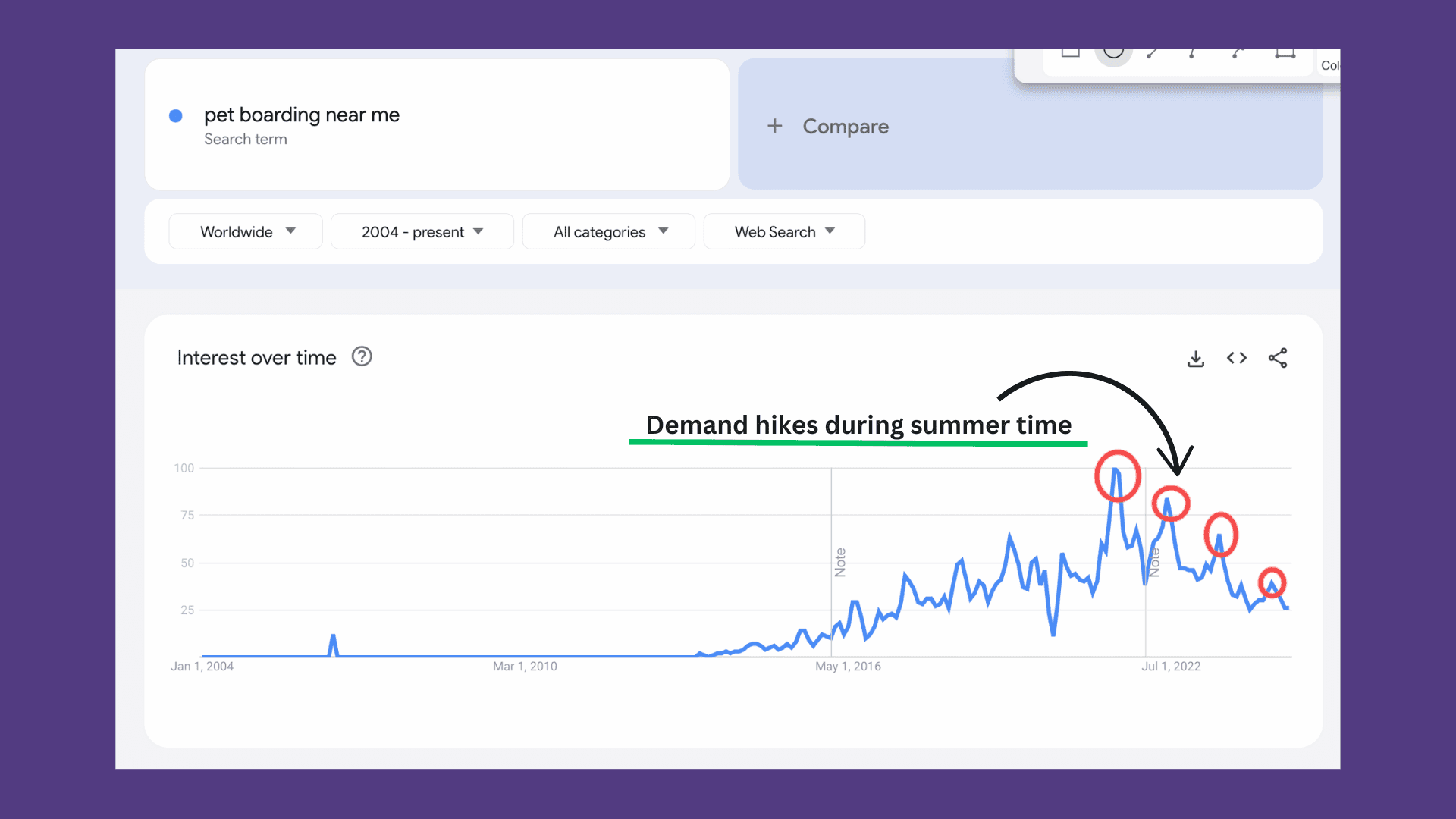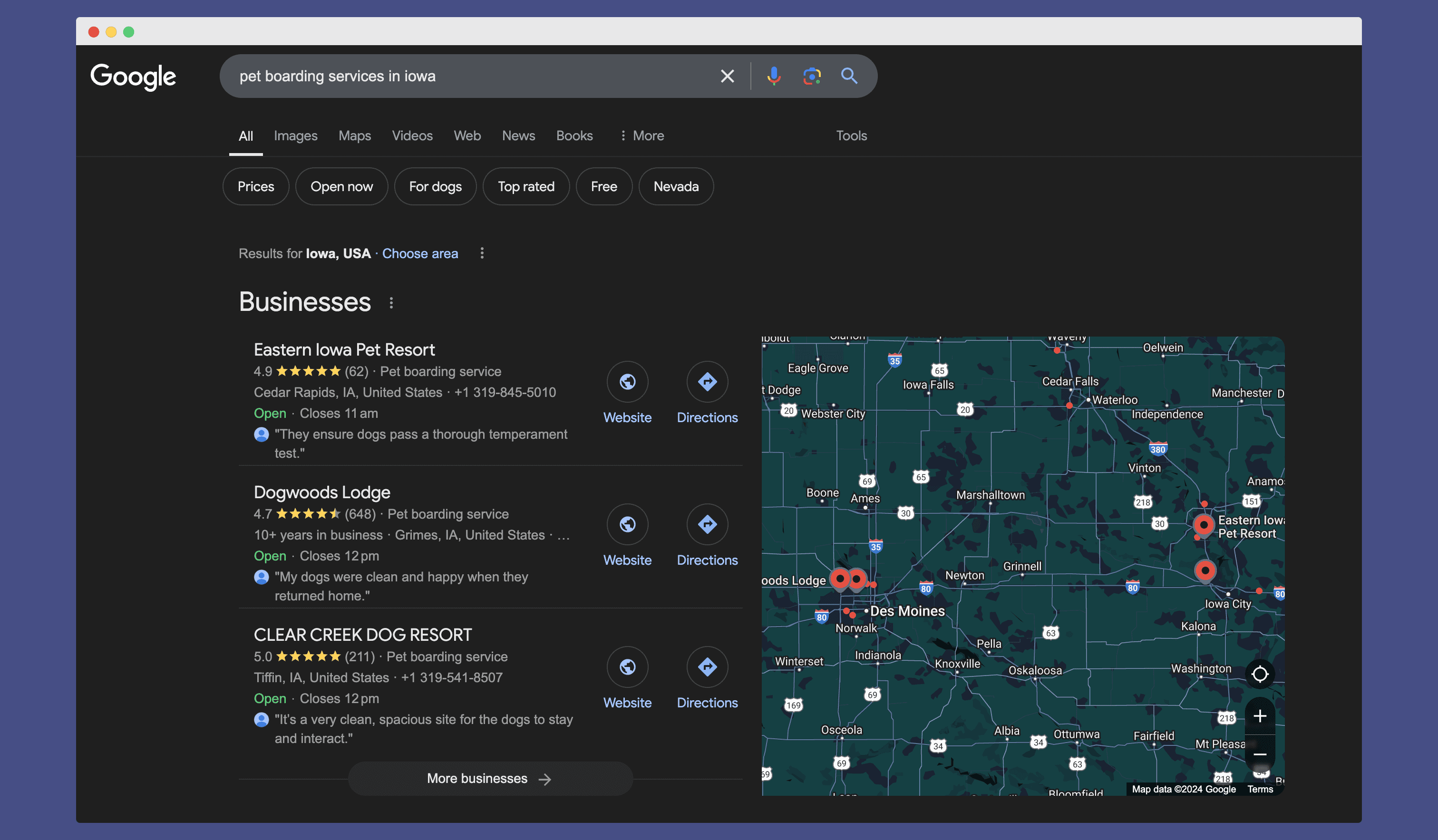The Complete Guide To Starting A Pet Boarding Business From Home
The Complete Guide To Starting A Pet Boarding Business From Home



Introduction
Introduction
Thinking of turning your love for animals into a profitable home business? Pet boarding could be the ideal venture for you! As more pet owners look for affordable, trusted, and comfortable alternatives to traditional kennels, home-based pet boarding has surged in popularity. This guide breaks down all you need to get started, from legal requirements to setting up your space, handling pets, and marketing your business. By the end, you’ll have a clear roadmap to launch and run a pet boarding business from the comfort of your home.
I've observed that this type of business experiences significant demand during the summer months. As people frequently travel or go on vacation during this time, there is a clear need for reliable pet care services.
(see below)


(Now let's do the calculation)
Earning $100 a day for 20 days, excluding weekends, results in a solid $2,000 a month. If you choose to work only on weekends, you're looking at $200 per weekend, totaling $800 a month—assuming there are four weekends in a month. That’s an additional $800 in your pocket!
Thinking of turning your love for animals into a profitable home business? Pet boarding could be the ideal venture for you! As more pet owners look for affordable, trusted, and comfortable alternatives to traditional kennels, home-based pet boarding has surged in popularity. This guide breaks down all you need to get started, from legal requirements to setting up your space, handling pets, and marketing your business. By the end, you’ll have a clear roadmap to launch and run a pet boarding business from the comfort of your home.
I've observed that this type of business experiences significant demand during the summer months. As people frequently travel or go on vacation during this time, there is a clear need for reliable pet care services.
(see below)


(Now let's do the calculation)
Earning $100 a day for 20 days, excluding weekends, results in a solid $2,000 a month. If you choose to work only on weekends, you're looking at $200 per weekend, totaling $800 a month—assuming there are four weekends in a month. That’s an additional $800 in your pocket!
Contents
Boost your business visibility to thousands of engaged readers!
Get Featured on 100+ pages across the FounderNoon website.
One month stretch ⇢ $100
Three-month stretch ⇢ $250
Boost your business visibility to thousands of engaged readers!
Get Featured on 100+ pages across the FounderNoon website.
One month stretch ⇢ $100
Three-month stretch ⇢ $250
Contents
Why Start a Home-Based Pet Boarding Business?
Why Start a Home-Based Pet Boarding Business?
Pet boarding is booming as people want more personalized care for their furry friends. Starting from home has advantages:
Lower overhead: No extra rent or utilities to worry about.
Convenience: You’re right at home, so managing pets and personal life can be easier.
Personalized service: With fewer pets, you can offer a more hands-on approach than larger facilities.
If you love animals and want a low-cost, rewarding business, this is a fantastic way to combine passion with profit!
Pet boarding is booming as people want more personalized care for their furry friends. Starting from home has advantages:
Lower overhead: No extra rent or utilities to worry about.
Convenience: You’re right at home, so managing pets and personal life can be easier.
Personalized service: With fewer pets, you can offer a more hands-on approach than larger facilities.
If you love animals and want a low-cost, rewarding business, this is a fantastic way to combine passion with profit!
1. Understanding Your Local Market Demand
1. Understanding Your Local Market Demand
Before you dive in, let’s make sure there’s a market for your services.
Is There Demand in Your Area?
It’s crucial to assess whether pet owners in your area are looking for boarding options. Start by:
Checking out other local boarding options: Are they full? Do they have waiting lists? This can be a big indicator of demand.
Talking to local pet owners: Pet stores, dog parks, and vet clinics are great places to connect with owners and ask about their boarding preferences.
Researching trends: Pet ownership has been on the rise for years, and more people are treating pets like family, which means more demand for high-quality boarding services.
Before you dive in, let’s make sure there’s a market for your services.
Is There Demand in Your Area?
It’s crucial to assess whether pet owners in your area are looking for boarding options. Start by:
Checking out other local boarding options: Are they full? Do they have waiting lists? This can be a big indicator of demand.
Talking to local pet owners: Pet stores, dog parks, and vet clinics are great places to connect with owners and ask about their boarding preferences.
Researching trends: Pet ownership has been on the rise for years, and more people are treating pets like family, which means more demand for high-quality boarding services.
2. Legal Requirements
2. Legal Requirements
Let’s talk about the not-so-fun stuff that’ll keep you out of trouble. Like any business, pet boarding has rules and requirements, and they’ll vary depending on where you’re located.
Licensing & Permits
Each state or local government may have specific requirements. In Iowa, for instance, check with your local county office to see if there are any state-specific licenses or animal welfare regulations.
Business License: This is often required by your city or county, even if you’re operating from home.
Animal Boarding Permit: Some areas require permits specifically for boarding animals. This may include inspections to ensure you have a safe, clean environment for pets.
Zoning Laws
Since you’re using your home, make sure you’re zoned for business activities. Many residential areas permit home-based businesses, but if your local zoning restricts businesses, you may need to apply for an exception or special use permit.
Insurance Requirements
Pet care can come with risks, so insurance is key. Look into:
General Liability Insurance: Covers accidents or damage.
Pet Care Insurance: Specifically designed to cover risks like pet injuries, loss, or theft. Insurance can seem like an extra expense, but it’s a must if you want peace of mind.
Let’s talk about the not-so-fun stuff that’ll keep you out of trouble. Like any business, pet boarding has rules and requirements, and they’ll vary depending on where you’re located.
Licensing & Permits
Each state or local government may have specific requirements. In Iowa, for instance, check with your local county office to see if there are any state-specific licenses or animal welfare regulations.
Business License: This is often required by your city or county, even if you’re operating from home.
Animal Boarding Permit: Some areas require permits specifically for boarding animals. This may include inspections to ensure you have a safe, clean environment for pets.
Zoning Laws
Since you’re using your home, make sure you’re zoned for business activities. Many residential areas permit home-based businesses, but if your local zoning restricts businesses, you may need to apply for an exception or special use permit.
Insurance Requirements
Pet care can come with risks, so insurance is key. Look into:
General Liability Insurance: Covers accidents or damage.
Pet Care Insurance: Specifically designed to cover risks like pet injuries, loss, or theft. Insurance can seem like an extra expense, but it’s a must if you want peace of mind.
3. Setting Up Your Space for Pet Boarding
3. Setting Up Your Space for Pet Boarding
Creating a pet-safe, inviting environment is essential. Your clients need to trust that their pets are in a clean, comfortable space.
Creating a Pet-Friendly Environment
Think about what pets need to feel safe and happy:
Separate Spaces: If possible, set up separate spaces for different pets to avoid stress, especially for animals that may not get along.
Comfortable Sleeping Areas: Beds, crates, or mats – create a variety of options so pets feel at home.
Secure Outdoor Space: A fenced yard is ideal for exercise. If you don’t have one, make sure pets have a place to play safely indoors or invest in pet playpens.
Safety and Sanitation
Pet-Proofing: Remove anything harmful like exposed cords, toxic plants, or small items that could be swallowed.
Cleanliness: Regular cleaning is non-negotiable. Invest in quality cleaning products that are pet-safe to handle fur, spills, and messes.
Creating a pet-safe, inviting environment is essential. Your clients need to trust that their pets are in a clean, comfortable space.
Creating a Pet-Friendly Environment
Think about what pets need to feel safe and happy:
Separate Spaces: If possible, set up separate spaces for different pets to avoid stress, especially for animals that may not get along.
Comfortable Sleeping Areas: Beds, crates, or mats – create a variety of options so pets feel at home.
Secure Outdoor Space: A fenced yard is ideal for exercise. If you don’t have one, make sure pets have a place to play safely indoors or invest in pet playpens.
Safety and Sanitation
Pet-Proofing: Remove anything harmful like exposed cords, toxic plants, or small items that could be swallowed.
Cleanliness: Regular cleaning is non-negotiable. Invest in quality cleaning products that are pet-safe to handle fur, spills, and messes.

















2,678+ people enjoy it
➤ Every week, we dig up stories of how regular people started and grew their businesses—
➤ Plus the marketing hacks that won them customers.
➤ Then, we share those insights with you.
➤ Every week, we dig up stories of how regular people started and grew their businesses—
➤ Plus the marketing hacks that won them customers.
➤ Then, we share those insights with you.
4. Setting Up Services & Pricing
4. Setting Up Services & Pricing
Decide what you’ll offer and set your pricing based on your services and location.
Defining Services
Pet boarding isn’t one-size-fits-all. Think about what will make your business stand out:
Overnight Boarding: The main service where pets stay over several days.
Daycare: For clients who need a safe place for their pets during work hours.
Extras: Grooming, basic training, or photo updates can be valuable add-ons that boost income.
Pricing Your Services
Research what other pet boarding businesses are charging in your area. Be realistic about your costs:
Location Matters: Urban areas typically have higher prices.
Service Levels: Full-service care will warrant a higher price than basic care.
Bundles: Offering packages (e.g., 5-day daycare bundles) can attract more customers and increase loyalty.
Decide what you’ll offer and set your pricing based on your services and location.
Defining Services
Pet boarding isn’t one-size-fits-all. Think about what will make your business stand out:
Overnight Boarding: The main service where pets stay over several days.
Daycare: For clients who need a safe place for their pets during work hours.
Extras: Grooming, basic training, or photo updates can be valuable add-ons that boost income.
Pricing Your Services
Research what other pet boarding businesses are charging in your area. Be realistic about your costs:
Location Matters: Urban areas typically have higher prices.
Service Levels: Full-service care will warrant a higher price than basic care.
Bundles: Offering packages (e.g., 5-day daycare bundles) can attract more customers and increase loyalty.
5. Marketing Your Pet Boarding Business
5. Marketing Your Pet Boarding Business
Marketing is your ticket to success, especially when starting out. Here’s how to make it effective:
Building an Online Presence
Create a Simple Website: List your services, prices, and contact info. You can easily build a site with platforms like Wix or Squarespace.
Google My Business: Setting up a Google profile helps you appear in local searches and adds credibility.
(examples of Google My Business profiles for pet boarding services)

Customer Reviews: Encourage clients to leave reviews; these go a long way in building trust.
Using Social Media
Showcase your furry guests, share updates, and engage with local pet communities on social media:
Instagram and Facebook: Post photos, videos, and even “pet stories” of the pets you board (with owner permission).
Community Groups: Join local groups for pet lovers and offer advice or tips to establish your presence.
Networking Locally
Connect with pet-related businesses:
Vets and Groomers: Offer to display flyers at vet offices and groomers.
Pet Stores: Partner with stores to offer mutual discounts or promotions.
Marketing is your ticket to success, especially when starting out. Here’s how to make it effective:
Building an Online Presence
Create a Simple Website: List your services, prices, and contact info. You can easily build a site with platforms like Wix or Squarespace.
Google My Business: Setting up a Google profile helps you appear in local searches and adds credibility.
(examples of Google My Business profiles for pet boarding services)

Customer Reviews: Encourage clients to leave reviews; these go a long way in building trust.
Using Social Media
Showcase your furry guests, share updates, and engage with local pet communities on social media:
Instagram and Facebook: Post photos, videos, and even “pet stories” of the pets you board (with owner permission).
Community Groups: Join local groups for pet lovers and offer advice or tips to establish your presence.
Networking Locally
Connect with pet-related businesses:
Vets and Groomers: Offer to display flyers at vet offices and groomers.
Pet Stores: Partner with stores to offer mutual discounts or promotions.
6. Managing Daily Operations
6. Managing Daily Operations
Running a boarding business means handling the daily details smoothly to keep pets safe and clients happy.
Booking and Scheduling
Consider using a simple online booking tool to manage reservations, track payments, and reduce double bookings. Calendly, Google Calendar, or a dedicated pet business tool like Gingr can help.
Intake and Health Protocols
For new pets, conduct a brief health and behavior assessment. Require proof of vaccinations to maintain a safe environment.
Pet Safety & Emergency Plans
Have a plan in place for emergencies. Partner with a nearby vet if possible, and know the closest emergency vet clinic just in case.
Running a boarding business means handling the daily details smoothly to keep pets safe and clients happy.
Booking and Scheduling
Consider using a simple online booking tool to manage reservations, track payments, and reduce double bookings. Calendly, Google Calendar, or a dedicated pet business tool like Gingr can help.
Intake and Health Protocols
For new pets, conduct a brief health and behavior assessment. Require proof of vaccinations to maintain a safe environment.
Pet Safety & Emergency Plans
Have a plan in place for emergencies. Partner with a nearby vet if possible, and know the closest emergency vet clinic just in case.
7. Building Trust
7. Building Trust
Repeat clients are the bread and butter of any boarding business. Keep clients coming back by creating a great experience for both pets and owners.
Client Communication
Regular updates with photos, videos, or text messages reassure owners that their pet is happy and safe. Make it easy for clients to reach you with questions.
Customer Loyalty and Referrals
Offer discounts or perks for repeat clients. Consider a referral discount for clients who bring in new business. Word-of-mouth recommendations are powerful in the pet industry!
Repeat clients are the bread and butter of any boarding business. Keep clients coming back by creating a great experience for both pets and owners.
Client Communication
Regular updates with photos, videos, or text messages reassure owners that their pet is happy and safe. Make it easy for clients to reach you with questions.
Customer Loyalty and Referrals
Offer discounts or perks for repeat clients. Consider a referral discount for clients who bring in new business. Word-of-mouth recommendations are powerful in the pet industry!
8. Preparing for Challenges
8. Preparing for Challenges
Every business has bumps along the way. Here’s how to navigate the main ones in pet boarding.
Handling Behavioral Issues
Sometimes pets are nervous or act out in a new environment. Simple techniques like calming music, treats, or extra playtime can help. Always communicate any issues with pet owners.
Financial Management
Keep track of all expenses, from pet supplies to marketing costs. Consider simple tools like QuickBooks to manage finances or track your cash flow.
Every business has bumps along the way. Here’s how to navigate the main ones in pet boarding.
Handling Behavioral Issues
Sometimes pets are nervous or act out in a new environment. Simple techniques like calming music, treats, or extra playtime can help. Always communicate any issues with pet owners.
Financial Management
Keep track of all expenses, from pet supplies to marketing costs. Consider simple tools like QuickBooks to manage finances or track your cash flow.
Conclusion
Conclusion
Starting a pet boarding business from home is a fantastic way to combine your love for animals with a profitable venture. Follow these steps, and you’ll be well on your way to providing a safe, enjoyable home for pets in need of care. Remember, every happy pet and satisfied client builds your reputation – and word travels fast in the pet community!
Do me a favor and pass this on to a friend or share on X/reddit? It'll take just 20 seconds—this one took me about 7 hours to research and write 🫠
P.S. I’ve got a weekly newsletter where I share stories about founders who have started successful online businesses, growth strategies, and tips to start/grow your own business. I would love for you to join here
Read the full email here.
Starting a pet boarding business from home is a fantastic way to combine your love for animals with a profitable venture. Follow these steps, and you’ll be well on your way to providing a safe, enjoyable home for pets in need of care. Remember, every happy pet and satisfied client builds your reputation – and word travels fast in the pet community!
Do me a favor and pass this on to a friend or share on X/reddit? It'll take just 20 seconds—this one took me about 7 hours to research and write 🫠
P.S. I’ve got a weekly newsletter where I share stories about founders who have started successful online businesses, growth strategies, and tips to start/grow your own business. I would love for you to join here
Read the full email here.






